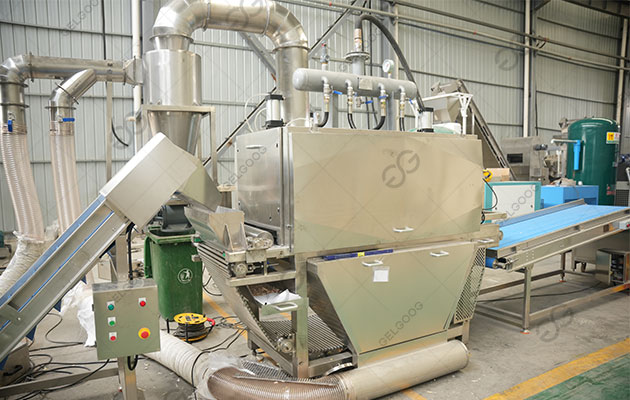Blog

Starting a Garlic Peeling Business Guide
2025-02-19
2025-02-19
Starting a Garlic Peeling Industrial Business: A Comprehensive Guide
Garlic is a staple ingredient in kitchens around the world, known for its pungent flavor and numerous health benefits. However, peeling garlic can be a tedious and time-consuming task, especially for large-scale food processors, restaurants, and manufacturers. This is where a garlic peeling industrial business comes into play. By offering pre-peeled garlic, you can tap into a growing market and provide a valuable service to businesses that rely on this versatile ingredient.
If you're considering starting a garlic peeling industrial business, this guide will walk you through the essential steps, from market research to equipment selection and operational strategies.
1. Understanding the Market Demand
Before diving into the business, it's crucial to understand the market demand for pre-peeled garlic. Conduct thorough research to identify your target customers, such as:
Food processing companies (sauces, soups, ready-to-eat meals)
Restaurants and catering services
Supermarkets and grocery stores
Export markets (if you plan to sell internationally)
Analyze your competitors, their pricing strategies, and the quality of their products. This will help you identify gaps in the market and position your business effectively.
2. Creating a Business Plan
A well-structured business plan is the foundation of any successful venture. Your plan should include:
Executive Summary: A brief overview of your business goals and vision.
Market Analysis: Insights into the demand for pre-peeled garlic and your target audience.
Operational Plan: Details about the peeling process, equipment, and workflow.
Financial Plan: Budget, pricing strategy, and revenue projections.
Marketing Strategy: How you plan to attract and retain customers.
A solid business plan will not only guide your operations but also help you secure funding if needed.
3. Sourcing Garlic
The quality of your product depends on the garlic you source. Look for reliable suppliers who can provide fresh, high-quality garlic consistently. Consider factors such as:
Variety of garlic: Different varieties have different peeling characteristics.
Seasonality: Garlic availability and prices may fluctuate based on the season.
Organic vs. conventional: Decide whether you want to cater to the organic market or stick with conventional garlic.
Building strong relationships with farmers or wholesalers can ensure a steady supply of raw materials.
4. Investing in the Right Equipment
Efficiency is key in an industrial garlic peeling business. Investing in the right equipment will save time, reduce labor costs, and ensure consistent quality. Some essential machinery includes:
Garlic Peeling Machine: These machines use air pressure or rubber rollers to peel garlic cloves efficiently.
Sorting and Grading Machines: To separate peeled garlic by size and quality.
Packaging Machines: For sealing and labeling the final product.
Storage Facilities: Cold storage units to maintain freshness.
Choose equipment that matches your production scale and budget. You can start small and upgrade as your business grows.


5. Setting Up Your Facility
Your production facility should be designed for efficiency and hygiene. Key considerations include:
Location: Choose a location close to your suppliers and customers to reduce transportation costs.
Layout: Ensure a smooth workflow from receiving raw garlic to packaging the final product.
Compliance: Adhere to food safety regulations and obtain necessary licenses and certifications.
Sanitation: Maintain a clean and hygienic environment to prevent contamination.
6. Developing a Quality Control Process
Quality control is critical in the food industry. Implement strict quality checks at every stage of production to ensure your peeled garlic meets industry standards. This includes:
Inspecting raw garlic for freshness and defects.
Monitoring the peeling process to minimize damage to cloves.
Ensuring proper packaging to extend shelf life.
Conducting regular lab tests for microbial contamination.
High-quality products will help you build a strong reputation and attract repeat customers.
7. Packaging and Branding
Packaging plays a significant role in attracting customers and preserving the quality of your product. Consider the following:
Packaging Materials: Use food-grade, airtight packaging to maintain freshness.
Shelf Life: Clearly label the expiration date and storage instructions.
Branding: Create a memorable brand name and logo that reflects your commitment to quality.
Eco-friendly packaging options can also appeal to environmentally conscious customers.
8. Marketing and Sales Strategies
To succeed in the competitive food industry, you need a robust marketing and sales strategy. Some effective approaches include:
B2B Sales: Reach out to food processors, restaurants, and supermarkets directly.
Trade Shows: Participate in food industry events to network with potential clients.
Referral Programs: Offer incentives to existing customers for referring new clients.
Building strong relationships with your customers and delivering consistent quality will help you grow your business.
9. Managing Finances
Proper financial management is essential for the sustainability of your business. Keep track of your expenses, revenue, and profit margins. Consider the following:
Pricing Strategy: Set competitive prices that cover your costs and generate profit.
Cash Flow Management: Ensure you have enough working capital to cover operational expenses.
Funding Options: Explore loans, grants, or investors if you need additional capital.
Regularly review your financial performance and adjust your strategies as needed.
10. Scaling Your Business
Once your business is established, you can explore opportunities for growth. This may include:
Expanding Your Product Line: Offer minced garlic, garlic paste, or other value-added products.
Entering New Markets: Explore export opportunities or target new customer segments.
Automating Processes: Invest in advanced machinery to increase production capacity.
Scaling your business requires careful planning and investment, but it can significantly boost your revenue and market presence.
Conclusion
Starting a garlic peeling industrial business can be a rewarding venture, especially with the growing demand for convenience in the food industry. By following this guide, you can set up a successful operation that delivers high-quality products and meets the needs of your customers.
Remember, success in this business requires a combination of quality, efficiency, and customer satisfaction. With the right strategies and dedication, you can carve out a niche in the market and build a thriving garlic peeling business.
Recommended:
Pre:Commercial Dates Washing Cleaning Air Drying Machine Line: Streamlining Your Date Processing Needs
